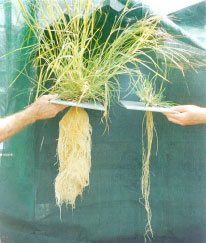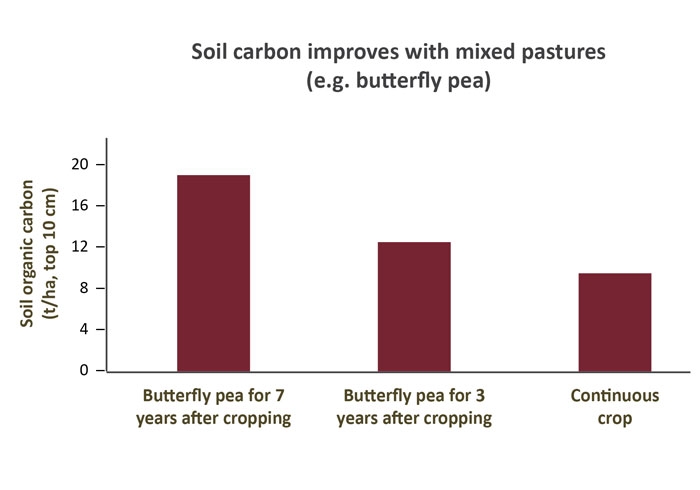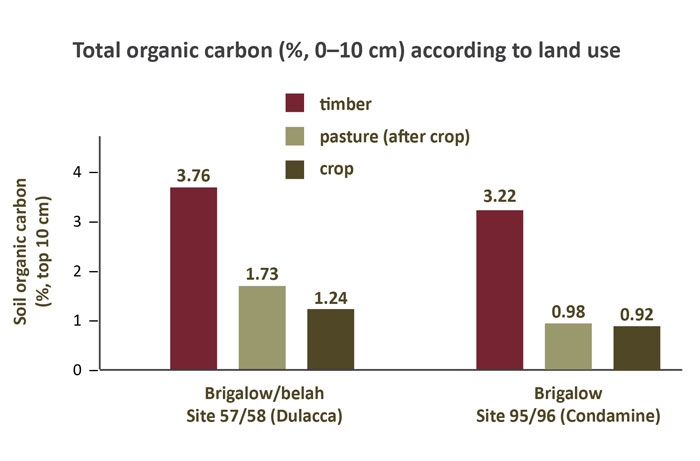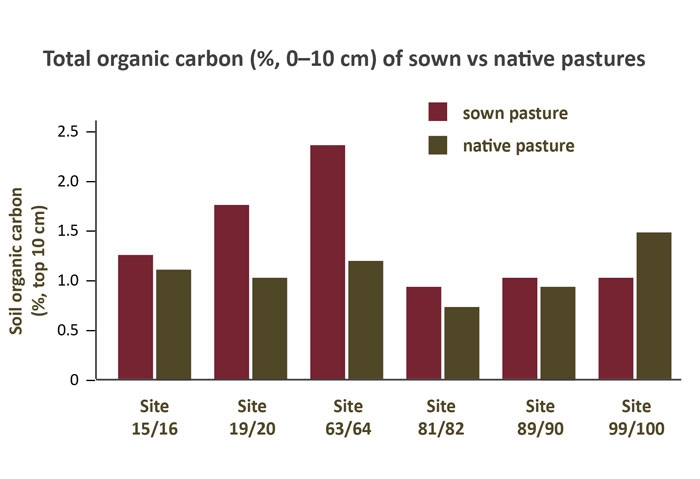Soil organic matter and carbon sequestration in pastures
This page addresses some of the questions from producers about organic matter, soil organic carbon, the impacts of cropping on soil carbon, and the potential to sequester carbon under pastures.
Soil organic matter and soil organic carbon
Organic matter is critical for healthy soils that support productive pastures. It makes soils resilient by providing food for soil microbes, provides a store of relatively available nutrients, and bonds soil particles for a stable structure. This organic matter includes living plants, animals and microbes, as well as litter on the soil surface and degrading and decomposing materials.
The soil biota (soil animals, plants, microbes) and the types of soil organic matter depend on soil moisture, temperature and the quantity and quality of the plant materials returned to the soil. The length of time various types of organic matter last in the soil, for example:
- Plant residues on the soil surface (last for weeks–months)
- Buried plant residues and roots (last for months–years)
- Small fragments of ‘particulate’ organic matter that provide energy for microbes (last for years–decades)
- Highly decomposed ‘humus’ that supplies slow release nutrients for plants (lasts for decades–centuries)
- Resistant relatively inert organic matter (lasts for centuries–millennia)
Soil organic carbon is used to estimate organic matter levels. Organic matter is about 60% carbon, so soils with 1% organic carbon will contain about 1.7% organic matter. Most agricultural soils in Queensland contain 0.5–2.5% total organic carbon in the top 10cm of soil, which roughly equates to 5–25t/ha of organic carbon or 8–40t/ha of organic matter.
That’s a lot of carbon and shows why soils are the third largest store of carbon on earth after oceans and geologic sinks like coal seams. Indeed, there’s 2–4 times more carbon in soils than there is in the atmosphere and about 4 times more in soils than in all the vegetation on the earth. So while many people talk about planting trees, beef producers are interested in their ability to sequester carbon in their soils to improve their ‘carbon budgets’.
Australia’s hot and relatively dry climate and the high costs of measuring soil carbon makes the current economics of sequestration difficult, but there are opportunities to increase soil organic carbon which will help and also make soils healthier. To recognise these opportunities we need to understand how carbon works and why we have the current levels of soil carbon.
Soil organic carbon levels reflect inputs and breakdown
The level of organic carbon in the soil is determined by the balance between the amount of dry matter grown and returned to the soil and the rate at which the organic carbon in the soil is broken down by soil fauna and microbes. Consequently, soil carbon levels tend to be highest in cool wet climates where there is plenty of water to grow lots of dry matter and the cool conditions slow the rate of decomposition.
Ways to increase soil organic carbon in grazing systems
Beef producers can increase soil organic carbon by growing the best pastures they can and returning more dry matter to the soil. In Queensland, much of this extra carbon will then break down in our warm conditions to benefit our soils (support soil microbes, supply nutrients, maintain structure) and improve our soil carbon levels. So, growing better pastures that produce more dry matter will sequester more carbon and make soils more resilient.
Key practices for achieving this are:
- grazing to maintain ‘pasture species’ that are palatable, perennial and productive (3P)
- keeping at least 40% cover to maximise water infiltration
- introducing legumes to minimise nitrogen deficiency in grass pastures, and
- considering phosphorus fertiliser to maintain production.
These practices will maintain the health of perennial grass tussocks that would suffer and produce less dry matter if subjected to prolonged heavy grazing (Figure 1). Good grazing practices also minimise the erosion which can dramatically reduce levels of soil organic carbon levels by removing the topsoil into which most of the organic matter has been deposited.

Carbon losses and gains in mixed farming–grazing systems
Soil organic carbon levels usually decline from their native levels when we grow annual crops. Indeed, a recent ‘Healthy Soils’ project compared carbon levels on over 140 grain farms and showed that cropping typically reduces soil organic carbon levels by about 40%. This loss of between 5t/ha and 10t/ha of soil organic carbon (or 8t/ha to 17t/ha of organic matter) reduces the soil’s ability to support biological activity and supply nutrients such as nitrogen to crops. It also reduces the capital value of the land because each 0.1% change in soil organic carbon on a soil test (or 1.7 tonne of good quality soil organic matter) may contain up to $200 worth of nitrogen, phosphorus and other nutrients. These losses occur because:
- annual crops produce less dry matter than perennial native systems
- cultivation breaks soil aggregates and exposes organic carbon to decomposition
- erosion removes surface soil that is rich in organic carbon
- fallowing for soil moisture keeps the soil moister, which leads to more decomposition of soil organic carbon over summer than native systems that keep the soil dry (our fallows store only 20–25% of the rainfall; most of our rain is wasted as evaporation and grows little that contributes dry matter back to the soil)
- crop species break down faster and have less extensive root systems, and
- we harvest and remove product for sale.
Soil organic matter levels will then reach a new lower ‘equilibrium’ for cropping where the dry matter inputs equal the continuing decomposition of organic matter by soil biota. Remember, the amount (or lack) of dry matter returned to the soil is a key driver for the declining levels of soil organic matter in our crop lands. We can maximise the amount of dry matter returned in cropping systems by growing as many good crops as we can, maintaining stubble and never burning or baling stubbles.
Tillage and soil disturbance breaks open soil clogs and speeds up carbon breakdown to some extent. The major benefits of zero-tillage cropping systems in Australia come from growing more and bigger crops rather than from incorporating stubble. Forage crops that are grazed rather than baled will help maintain soil organic carbon levels because the dry matter is largely returned to the soil and not sold off-farm. Manures also help but break down very quickly and so we have to keep using them to maintain levels. We can also add charcoal or other ‘Char’ products which do lift the soil carbon levels but they are relatively inert and do little to improve the soil.
Research confirms the best strategy for building soil organic carbon is to grow perennial pastures that have extensive roots and produce more dry matter. Data from the ‘Healthy Soils’ project again shows what is possible. For example, the chart below shows the steady improvements in total soil organic carbon from 3 years and 7 years of a mixed grass and butterfly pea pasture on a heavy clay soil near Emerald. These pastures showed similar proportional increases in total nitrogen and microbial biomass and illustrate the potential for pastures to sequester carbon and rebuild resilience into these soils.

Figure 2. Soil carbon improves with mixed pastures (e.g. butterfly pea)
To date, there has been considerably less data available from extensive grazing systems for comparing soil organic carbon levels and the types of organic carbon that develop under different pastures and grazing management systems. However, recent Department of Agriculture, Fisheries and Forestry projects funded by the Commonwealth FarmReady Industry Grants and by the Grains Research and Development Corporation and the Australian Government’s Climate Change Research Program are providing good local data on soil carbon changes across Queensland. These projects are confirming that the ability of pastures to rebuild soil organic matter after cropping depends on the productivity of these pastures (Figure 3) and that sown pastures will often produce more dry matter and so have higher soil organic carbon levels than native pastures on the same soils…unless the soils have major nutrient deficiencies from poor cropping practices in the past (Figure 4).

Figure 3. Land use – total organic carbon (per cent 0–10cm)

Figure 4. Total organic carbon (per cent 0–10cm) – sown versus native pastures
Further information
Soil carbon sequestration: myths and mysteries (PDF, 107KB) →
Soil biology →
Written by David Lawrence, Department of Agriculture and Fisheries, and Mike Bell, formerly Queensland Government.